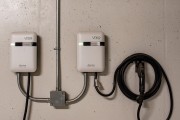The clean energy evolution has become a global movement and the good news is everybody can get involved. In particular, municipalities can play an important role in making clean energy opportunities available to their citizens.
Monday, as part of our Climate Week events, and in advance of his panel session at the Alberta Climate Summit in Calgary, Mayor Dale Ross sat down with Edmonton Mayor Don Iveson for a conversation about advancing renewable energy within their cities. Ross is the Republican mayor of politically conservative Georgetown, Texas, which is the largest U.S. city to run on 100 per cent renewable energy. Edmonton also has a 100 per cent renewable energy target. And last March, Mayor Iveson initiated the Edmonton Declaration, urging other municipalities to play a leadership role in transitioning responsibly to a low-carbon future and reducing the effects of climate change.
The conversation highlighted not just that action at the municipal level is a meaningful way to mitigate climate change and clean up the air for healthier communities – it’s also good business.
Enabling clean energy projects can help communities diversify their economy and promote development. Let’s take the example of renewable energy. There is an economic case for municipalities doubling down on solar. It can help consumers manage their electricity costs over the long term. It helps the growth of small businesses providing solar installation services. It attracts investment into the community, and lastly, it enables community and business partnerships through local solar projects. This is why there is a worldwide movement of cities taking more climate action and investing in clean energy solutions. Albertan municipalities have recognized this and have started taking action.
Several municipalities have layered solar incentives on top of the provincial rebate program managed by Energy Efficiency Alberta. For example, Medicine Hat created a rebate program to help residents invest in solar, discounting 75 cents per watt to a maximum of $5,000. This led to 151 residential solar installations in the community. Banff offered a similar rebate up to $5,625 – it’s been so successful applications for the 2018 program are already closed. Edmonton announced in June an incentive of 15 cents per watt for residential properties.
Municipalities are also looking into harnessing private enterprise support for clean energy investment. Soon, the province of Alberta will allow and encourage municipalities to implement their own Property Assessed Clean Energy (PACE) finance program, which will allow homeowners to borrow money from an organization to install solar on their roof and pay back to the lender through their property taxes.
Beyond solar power, cities have other options for reducing their carbon footprint while investing in their communities. There are opportunities in transportation, buildings and waste. And there is a range of tools they can use in addition to creating incentive programs. They can adopt codes such as net-zero energy building codes. They can change their procurement policy, for example to replace their municipal fleet with electric vehicles.
For resources municipalities can look to Alberta’s Municipal Climate Change Action Centre as well as toolkits such as the Rocky Mountain Institute’s handbook that show examples of practical steps to take advantage of the clean energy evolution.
Whether you are a city councillor, municipal staff, or a citizen, you can drive your municipality to adopt programs that will help communities reap the benefits of the clean energy evolution.








